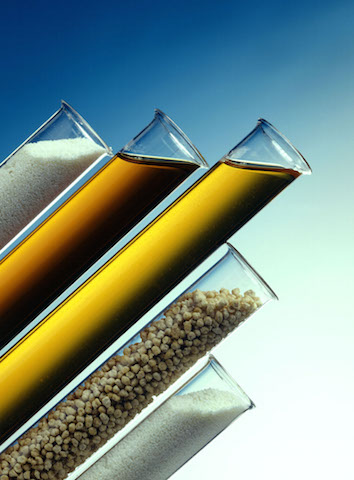We have all probably read the label on a package of food and wondered, “What the hell is butylated hydroxytoluene?!”
Sometimes it can feel overwhelming to sift through all of the information on typical packaged foods, such as calorie counts and percentages of daily nutritional values. Food packaging is designed to be confusing and to draw our attention away from the part of the package where all the most important information is: the ingredients section.
The secret to reading food labels is to go directly to the ingredients section where we can find a list of which raw materials our food is actually made of. We may often find a lot of ingredients with long, hard-to-pronounce names such as butylated hydroxytoluene. It can be a daunting task to identify all of these substances, most of which are food additives.
As a rule of thumb, it’s best to avoid consuming something if it’s unclear what the substance is. But because these ingredients are so common, I have created a quick guide detailing the purposes of five major food additives, which foods they are commonly found in and how they might appear on the label:
1. Emulsifiers and Stabilizers
Purpose: Emulsifiers make food look more appealing. Without an emulsifier, the water and the oil content in the food will separate, giving a very unappetizing appearance. Stabilizers act in a similar way by stopping the separation of ingredients bound together by emulsifiers.
Typically found in: margarine, mayonnaise, bread, biscuits, crackers, cakes, soft drinks and many other “snack items.”
Some examples of how emulsifiers and stabilizers appear on the ingredients label:
-Soy lecithin
-Monoglyceride
-Calcium Stearoyl Di Laciate
-Calcium chloride
2. Anti-caking Agents
Purpose: These food additives make products manageable for packaging, transport and use by the consumer. They keep powders or granulated materials—such as milk powder, powdered sugar or tea powders—flowing freely and prevent the formation of “lumps” in the food.
Typically found in: powdered coffee or cocoa, soup, milk and cream powders, baking powder, cake mixes, and table salt.
Some examples of how anti-caking agents appear on the ingredients label:
-Sodium aluminosilicate
-Magnesium carbonate
3. Artificial Coloring Agents
Purpose: Coloring agents add color to make the food “look like it should,” making it more appetizing to the consumer. They are also used to make food look interesting and fun for children, especially in breakfast cereals and candies.
Typically found in: cereals, popsicles, some meat and fish products, candies, sodas and many baked goods, although the list could go on and on.
Some examples of how artificial coloring agents appear on the ingredients label:
-Blue #1
-Red #40
-Yellow #5
4. Artificial Sweeteners
Purpose: To make the food taste better or to enhance the flavor of the food. These chemicals are different from simple natural sugars and without them most packaged foods would probably taste like the other chemicals they are made of. Take one taste of a preservative like sulfur dioxide and you will instantly understand why artificial sweeteners are used.
Typically found in: breakfast cereals, yogurt, salad dressing, sodas, ice cream, candy, jams, ketchup, and most store bought honey, just to mention a few.
Some examples of how artificial sweeteners appear on the ingredients label:
-High fructose corn syrup (HFCS)
-Aspartame
-Xylitol
-Saccharin
5. Preservatives
Purpose: To prevent the food from spoiling, extend its shelf life, and preserve the “natural” look of the food.
Typically found in: almost all types of packaged foods including oats, chips, microwave meals, crackers, cereal, pasta, bread, chocolate, wine, and juice.
Some examples of how preservatives appear on the ingredients label:
-Sodium Sulfite
-Sodium Nitrate
-Sulfur Dioxide
-Citric Acid
-Butylated hydroxytoluene
It’s interesting to note that the first word in the chemical name of many of these food additives is sometimes a mineral like potassium, magnesium or sodium, which most people probably recognize. When we see these substances on a label we think, “Oh yeah, sodium, that’s just salt.” This is a very common mistake—so don’t feel bad—but there is a major difference between sodium and sodium sulfite. Sodium is a vital mineral and electrolyte which supports fluid regulation, among other things, while sodium sulfite is a preservative which has toxic effects on the human body.
If it’s unclear what an ingredient is on the label, it’s really easy for us to pull out our smart phone and do a quick google search while we’re at the store. Usually, we can identify which category the ingredient falls under and determine if it’s something we want in our body or not. Any ingredient that comes up as a preservative, emulsifier, anti-caking agent, artificial sweetener or artificial coloring agent is most likely a chemical additive. There are natural food additives in many of these categories, although they are typically more expensive and as a result used much less often.
Most food additives are put into the food for a specific purpose—which is usually not to provide our body with essential minerals and vitamins.
To make a decision, all we have to do is ask ourselves:
- Did the company who produced this food add these specific ingredients to benefit my health?
- Or did they add it to extend shelf life, improve the appearance of the food, enhance the flavor
or increase their bottom line?
When I first began to investigate what all of these words found on food labels actually were, I was shocked at my discoveries. I was raised to be very trusting of the foods that I ate, never questioning where anything came from. I was alarmed to find out how disruptive many of these food additives are to the internal balance in the body, specifically to microbial communities which facilitate a number of essential biological processes in our intestinal tract.
I had been consuming so many of these additives my whole life and was worried that I had done irreversible damage to my body because of all of the processed foods I had consumed.
Since my initial investigations, I have come to understand that while long-term consumption of these substances is detrimental to health, it is by no means irreversible damage. There are a number of things we can do, aside from avoiding these additives, to reverse their damaging effects. For example, fasting detoxifies the system and consuming probiotic supplements restores healthy bacteria balance.
The best way to avoid food additives is to eat whole and natural foods. Many chemical substances disrupt the natural balance inside the body and are difficult to digest and eliminate, among a long list of other potentially hazardous side effects. Once we start to investigate the foods we are consuming, we soon find that it is extremely difficult to buy something in a package that doesn’t contain harmful food additives. It does requires more time and energy to find these products, but the long-term health benefits are well worth the effort.
~
Relephant:
5 “Healthy” Foods that Aren’t that Healthy.
12 Ways To Buy Food Mindfully.
~
Author: John Miller
Image: Wikimedia Commons
Apprentice Editor: Sarah Crosky; Editor: Nicole Cameron
~









Read 0 comments and reply